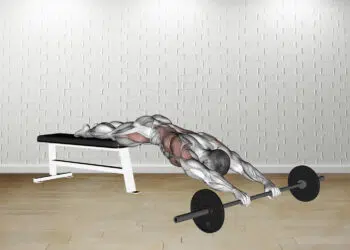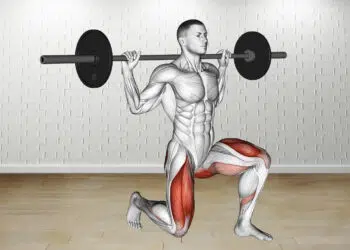The decline sit-up is a bodyweight exercise that targets the abdominal muscles. It’s very effective for building a strong core and you only need an incline bench to develop and strengthen these muscles of the midsection.
The abdominal muscles are responsible for daily functions like bending over, twisting, and stabilizing the body during weight training. So, the decline sit-up can be a great addition to your ab training routine and it can improve your training significantly if done with proper form and technique.
Not to mention, most people who train their core muscles are expecting a muscular and defined midsection. When you know what you’re doing, sit-ups are always a good exercise to add to your workouts to develop the core muscles.
Decline Sit-Up Muscles Worked
The decline sit-up targets the core muscles of the midsection and we’ve included brief descriptions of each one below.
Core muscles
The core consists of many different muscles that include the rectus abdominis, also known as the abdominals or abs, the obliques, deep core muscles, and spinal erectors.
The abs are the most familiar core muscle to most people and it functions to curl the pelvis and rib cage toward each like when you perform a crunch.
Level Up Your Fitness: Join our 💪 strong community in Fitness Volt Newsletter. Get daily inspiration, expert-backed workouts, nutrition tips, the latest in strength sports, and the support you need to reach your goals. Subscribe for free!
The obliques are located on either side of the abs and are responsible for rotation or twisting the torso. Then you have the deeper core muscles such as the transverse abdominis and internal obliques that help to draw the belly button to the spine and stabilize the trunk. This creates a rigid core which is important for safe heavy lifting and even playing sports for example.
Then you have the back extensors that allow us to stand up straight from a bent-over position and lean backward.
How To Do The Decline Sit-Up
Done incorrectly, the decline sit-up is not the best option to train the core muscles. Poor form is bad for the back plain and simple. We do not recommend this exercise for everyone and only suggest it for those who have proper training experience and a basic understanding of exercise technique.
It’s all in the pelvis
Before you start hammering away at sit-ups, there’s one important thing you must know if you don’t already. In case you haven’t noticed, we’re referring to the position of your pelvis, and more specifically, anterior and posterior tilt.
Anterior tilt is when the pelvis moves forward and creates a curve in the lower back. This would also create a space between the lower back and the floor.
Posterior tilt is when the pelvis is pushed back, creating a flat back where the lower back is flat against the floor.
When performing sit-ups, you want to maintain posterior tilt and never allow for anterior tilting of your pelvis. Anterior tilt causes shearing forces of the vertebrae against each other and this can be very dangerous for the spine.
The basic and decline sit-up are a little different regarding how the body is positioned and the range of motion. You may need to shorten the range of movement when doing the decline sit-up to maintain posterior tilt.
We’ve included step-by-step instructions below for proper execution of the decline sit-up.
- We recommend using a proper decline bench that will allow you to secure your ankles under the foam padding. You should also start with a small decline angle if new to the movement.
- Hop onto the bench and place your ankles under the support padding.
- Lie back on the bench but maintain posterior tilt of the pelvis and keep your back slightly rounded or hunched over. This may mean you cannot lie all the way back against the bench.
- If possible, avoid using your feet for the first rep as this may cause anterior pelvic tilt.
- Contract your core muscles and sit yourself up.
- Lie back against the bench and again, keep the posterior tilt and do not allow a space between your lower back and the bench.
We recommend taking a few minutes to watch this video below.
Decline sit-ups/what not to do
- The most important point to remember when doing the decline sit-up is that you want to maintain posterior tilt of the pelvis throughout the entire exercise. There should be no space between your lower back and the bench.
- Do not try to rush your progress. Focus on proper exercise execution before adding weight. Never use too much weight to where you’re straining or compromising posterior tilt of the pelvis.
- Adjust the decline position according to your experience level. The higher the bench the easier it will be to perform the exercise and vice versa.
- Avoid securing your feet especially at the beginning of the movement, if possible. This may cause a space between your back and the bench.
- If you’re more advanced, incorporate a medicine ball, weight plate, or dumbbell for added resistance.
- You can place your hands anywhere as long as you can still perform the exercise comfortably. Avoid pulling against your head or neck. Place your fingers or hands gently behind the head if you prefer to use this technique.
Decline Sit-Up Benefits
Let’s talk about the benefits of doing the decline sit-up and why you should do it for a better core.
Advanced sit-up
The decline sit-up should be more challenging than a standard sit-up because you have to overcome greater gravitational forces. This creates more constant tension on the muscles which may be more beneficial.
Real world application
There are many professions, activities, and sports where you’ll have to do sit-ups, although not necessarily how you’d do them in the gym or at home during your workout.
Similar to how you’d use good form to pick up a case of water at the store, you should always remember to use good form even if you’re not lifting weights.
This will not only prevent pain and injuries but it will help you to be mobile and healthy.
Great option for training variety and preventing boredom
If we’re being honest, even certain exercises get boring after a while (we’re just human). The advantage of doing decline sit-ups is that there are a few different ways to add a little spice and look forward to working your abs!
One of the best ways to do this is by using a medicine ball and a partner.
For example, you can have them stand by your feet, then as you sit-up, have them toss you the ball, lower yourself to the bench, sit back up, toss the ball back to them, have them toss it back to you, and repeat. You want to try and keep moving so that when your partner tosses you the medicine ball, you have to engage your core more to catch and hold it in position.
Decline Sit-Up Drawback/s
With positives there are always a few negatives.
Level Up Your Fitness: Join our 💪 strong community in Fitness Volt Newsletter. Get daily inspiration, expert-backed workouts, nutrition tips, the latest in strength sports, and the support you need to reach your goals. Subscribe for free!
You need a decline bench
One of the drawbacks of the sit-up is you need a decline bench to do this exercise. Sure you could get creative and use something other than a bench but for the majority of people, it’s not really an option especially if they train at home and have limited equipment.
Need a decline bench for home training? See our 11 best bench picks for 2022.
Can stress the back and spine
Sit-ups can place stress on the lower back when done incorrectly as we previously explained. It may be harder to maintain proper pelvic position during the decline variation compared to the basic sit-up so be careful when setting up and performing the movement. Reduce your range of movement if necessary.
That doesn’t mean you shouldn’t do it but we think it’s best left to more experienced exercisers who will remember to maintain proper form as it’s vital to the health of the back and spine.
Decline Sit-Up Variations
There are actually many great variations that you can do which not only keeps things interesting but also works the core muscles differently.
Added resistance
At some point and for some people, the basic bodyweight decline sit-up will not be as challenging. Of course you could do more reps and we recommend you do. You can also lower the bench further but you don’t want to strain the lower back by descending too far down. Eventually, you may need to add some resistance.
The best way to do this is by holding a medicine ball or weight. You can play catch with a partner at your feet or throw a medicine ball up into the air and catch it before lowering yourself back down.
Twisting decline sit-up
If you want to focus more on the oblique muscles, then give this variation a try. For this version, you’ll twist to either side and alternate every time you do a sit-up.
A fun way to do this is to pretend you’re throwing punches alternating both arms as you come up. This will place a greater emphasis on the oblique muscles and is also great for combat sports athletes.
Russian twists
Russian twists are a grueling ab exercise variation but they’re going to benefit you both by training your core but also your mental fortitude. It’s another variation that you can use to mix up your ab training.
How To Incorporate The Decline Sit-Up Into Your Workouts
The decline sit-up can fill many roles. Here are a few ways we recommend including it into your workouts.
Standalone ab exercise
The decline sit-up is challenging enough that if you’re short on time or can only do one ab exercise, it can be effective as a standalone exercise. We recommend using a variety of movements for every muscle group, however, it’s not always necessary for every workout.
Part of a core workout routine
The decline sit-up makes a great addition to a core workout program. Choose 3-4 ab exercises and do them in a logical order based on their anatomical functions.
For example, it’s best to start with a hanging leg raise variation as the weight of the legs will challenge you the most and you should start with the hardest variation when you have fresh strength.
Then you can do an exercise that involves the upper and lower body such as V-ups, followed by the decline sit-up, standing rotational cable work, and finally some reverse planks.
This will have your core screaming!
Circuit training
Circuit training is performing several exercises back to back with little to rest in between. The decline sit-up is a great option to throw in there, and not to mention, you could hold a medicine ball, weight plate, dumbbell, or something to add more resistance.
Related: Abs Circuit Workout: Training and Nutrition Tips for a Six-Pack
Sets and reps
There’s no perfect set and rep as this depends on the individual, workout structure, and goals. However, we can make basic sets and reps recommendations.
Strength
2-4 sets x 5-7 reps (An advanced variation using added resistance)
Hypertrophy (muscle growth)
3-4 sets x 8-12 reps
Muscular endurance
3 sets x 15-35 reps
Decline Sit-Ups Are A Viable Core Muscle Builder
The decline sit-up can be a very effective core-building exercise when done correctly. It’s not the best option for everyone but if you want it’s worth including in your ab training sessions. This ab variation is more challenging than basic crunches and sit-ups because of the greater gravitational forces and larger range of motion. However, it’s best suited for those who have some training experience.
Also read: 15 Best cable exercises for abs
Interested in measuring your progress? Check out our strength standards for Sit Ups, Decline Sit Up, Russian Twist, and more.








